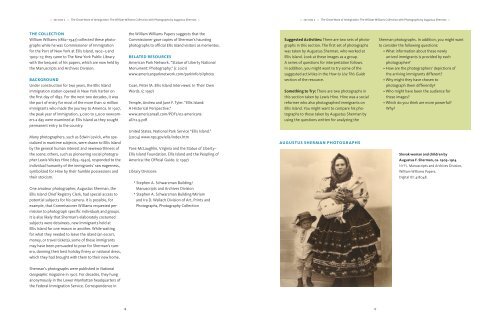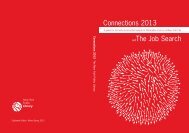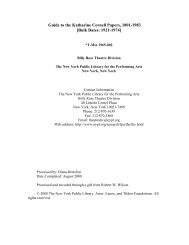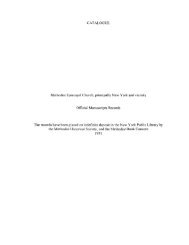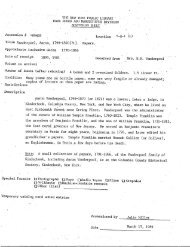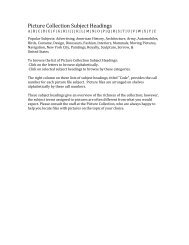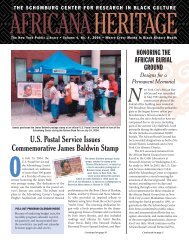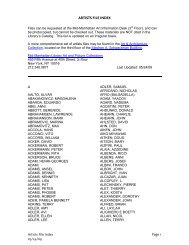Neighborhood Guide: The Lower East Side - New York Public Library
Neighborhood Guide: The Lower East Side - New York Public Library
Neighborhood Guide: The Lower East Side - New York Public Library
Create successful ePaper yourself
Turn your PDF publications into a flip-book with our unique Google optimized e-Paper software.
: : section 2 : : <strong>The</strong> Great Wave of Immigration: <strong>The</strong> William Williams Collection with Photographs by Augustus Sherman : : : : section 2 : : <strong>The</strong> Great Wave of Immigration: <strong>The</strong> William Williams Collection with Photographs by Augustus Sherman : :<br />
THE COLLECTION<br />
William Williams (1862–1947) collected these photographs<br />
while he was Commissioner of Immigration<br />
for the Port of <strong>New</strong> <strong>York</strong> at Ellis Island, 1902–5 and<br />
1909–13; they came to <strong>The</strong> <strong>New</strong> <strong>York</strong> <strong>Public</strong> <strong>Library</strong><br />
with the bequest of his papers, which are now held by<br />
the Manuscripts and Archives Division.<br />
BACKGROUND<br />
Under construction for two years, the Ellis Island<br />
immigration station opened in <strong>New</strong> <strong>York</strong> harbor on<br />
the first day of 1892. For the next two decades, it was<br />
the port of entry for most of the more than 12 million<br />
immigrants who made the journey to America. In 1907,<br />
the peak year of immigration, 3,000 to 5,000 newcomers<br />
a day were examined at Ellis Island as they sought<br />
permanent entry to the country.<br />
Many photographers, such as Edwin Levick, who specialized<br />
in maritime subjects, were drawn to Ellis Island<br />
by the general human interest and newsworthiness of<br />
the scene; others, such as pioneering social photographer<br />
Lewis Wickes Hine (1874–1940), responded to the<br />
individual humanity of the immigrants’ raw eagerness,<br />
symbolized for Hine by their humble possessions and<br />
their stoicism.<br />
One amateur photographer, Augustus Sherman, the<br />
Ellis Island Chief Registry Clerk, had special access to<br />
potential subjects for his camera. It is possible, for<br />
example, that Commissioner Williams requested permission<br />
to photograph specific individuals and groups.<br />
It is also likely that Sherman’s elaborately costumed<br />
subjects were detainees, new immigrants held at<br />
Ellis Island for one reason or another. While waiting<br />
for what they needed to leave the island (an escort,<br />
money, or travel tickets), some of these immigrants<br />
may have been persuaded to pose for Sherman’s camera,<br />
donning their best holiday finery or national dress,<br />
which they had brought with them to their new home.<br />
the William Williams Papers suggests that the<br />
Commissioner gave copies of Sherman’s haunting<br />
photographs to official Ellis Island visitors as mementos.<br />
RELATED RESOURCES<br />
American Park Network. “Statue of Liberty National<br />
Monument: Photography.” (c 2001)<br />
www.americanparknetwork.com/parkinfo/sl/photo<br />
Coan, Peter M. Ellis Island Interviews: In <strong>The</strong>ir Own<br />
Words. (c 1997)<br />
Temple, Andrea and June F. Tyler. “Ellis Island:<br />
A Historical Perspective.”<br />
www.americansall.com/PDFs/02-americansall/12.9.pdf<br />
United States. National Park Service “Ellis Island.”<br />
(2004) www.nps.gov/elis/index.htm<br />
Yans-McLaughlin, Virginia and the Statue of Liberty–<br />
Ellis Island Foundation. Ellis Island and the Peopling of<br />
America: the Official <strong>Guide</strong>. (c 1997)<br />
<strong>Library</strong> Divisions<br />
* Stephen A. Schwarzman Building/<br />
Manuscripts and Archives Division<br />
* Stephen A. Schwarzman Building/Miriam<br />
and Ira D. Wallach Division of Art, Prints and<br />
Photographs, Photography Collection<br />
Suggested Activities: <strong>The</strong>re are two sets of photographs<br />
in this section. <strong>The</strong> first set of photographs<br />
was taken by Augustus Sherman, who worked at<br />
Ellis Island. Look at these images as a group.<br />
A series of questions for interpretation follows.<br />
In addition, you might want to try some of the<br />
suggested activities in the How to Use This <strong>Guide</strong><br />
section of the resource.<br />
Something to Try: <strong>The</strong>re are two photographs in<br />
this section taken by Lewis Hine. Hine was a social<br />
reformer who also photographed immigrants on<br />
Ellis Island. You might want to compare his photographs<br />
to those taken by Augustus Sherman by<br />
using the questions written for analyzing the<br />
AUGUSTUS SHERMAN PHOTOGRAPHS<br />
Sherman photographs. In addition, you might want<br />
to consider the following questions:<br />
• What information about these newly<br />
arrived immigrants is provided by each<br />
photographer?<br />
• How are the photographers’ depictions of<br />
the arriving immigrants different?<br />
• Why might they have chosen to<br />
photograph them differently?<br />
• Who might have been the audience for<br />
these images?<br />
• Which do you think are more powerful?<br />
Why?<br />
Slovak woman and children by<br />
Augustus F. Sherman, ca. 1905–1914<br />
NYPL, Manuscripts and Archives Division,<br />
William Williams Papers.<br />
Digital ID: 418048.<br />
Sherman’s photographs were published in National<br />
Geographic magazine in 1907. For decades, they hung<br />
anonymously in the <strong>Lower</strong> Manhattan headquarters of<br />
the Federal Immigration Service. Correspondence in<br />
18 19


